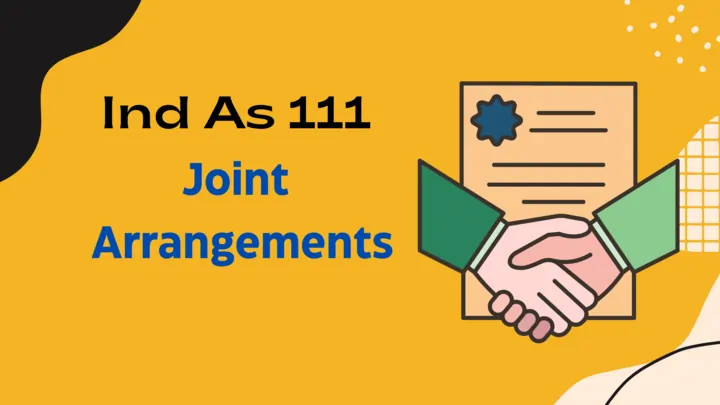Table of Contents
Ind AS 111, or Indian Accounting Standard 111, is a principle that governs the financial reporting of entities involved in joint arrangements. It provides a comprehensive framework for classifying and accounting for these arrangements, ensuring transparency and consistency in financial reporting. In this article, we will dive deep into the key aspects of this standard, including its scope, objectives, Accounting, and disclosure requirements.

Scope and Objective:
For entities involved in joint arrangements, understanding and applying Ind AS 111 is crucial to maintaining accurate and compliant financial records. The standard is applicable when an entity enters into a joint arrangement, which is defined as a contractual agreement where two or more parties share control over an economic activity. The standard aims to ensure that entities accurately report their rights, obligations, and financial performance arising from joint arrangements, enabling users of financial statements to make informed decisions.
What is Joint Arrangements
A joint arrangement is an arrangement where two or more parties share control. This control is contractually agreed upon and requires unanimous consent for decisions about relevant activities.
Ind AS 111 classifies joint arrangements into two categories: joint operations and joint ventures. while classifying these arrangements we have to confider rights and obligations of involved parties.
Joint Operations:
In a joint operation, the parties involved have joint control over the arrangement. parties also share the rights and obligations over the assets and liabilities. Each party has to directly recognize proportionate assets, liabilities, revenue, and expenses in its separate financial statements.
Joint Ventures:
In a joint venture, the parties also have joint control over the arrangement. However, the focus is on sharing the rights to the net assets of the arrangement rather than sharing the individual assets and liabilities. The joint venturers apply either the equity method or proportionate consolidation to account for their interests in the joint venture.
Classifying Joint Arrangements:
Hey there! Let me explain how joint arrangements are classified. Each entity of joint arrangements have to decide the type of arrangements by the way its right and obligation. This assessment considers factors like the arrangement’s structure, legal form, terms of the agreement, and other relevant facts.
Accounting for Joint Operations:
Now, when it comes to joint operations, things work slightly differently. In a joint operation, each joint operator has rights to specific assets and obligations for related liabilities. This means that each operator accounts for its share of assets, liabilities, revenues, and expenses.
Example of Joint Operations Accounting:
Imagine two companies, A and B, joining parties to manufacture and sell a product. Company A supplies the raw materials, while Company B contributes to the manufacturing facilities. Both companies share control over the operation. In this case, each party will recognize its portion of the assets, liabilities, revenues, and expenses in its SFS.
Accounting for Joint Operations:
In a joint venture, joint venturers have rights to the net assets of the arrangement. This means that a joint venturer recognizes its interest in the venture as an investment and accounts for it using the equity method.
Ind AS 111 interacts with Ind AS 28:
Investments in Associates and Joint Ventures, when accounting for joint ventures. The equity method, as prescribed by Ind AS 28, is used to account for investments in joint ventures.
Under the equity method, the investment is initially recognized at cost. The carrying amount is then adjusted for the investor’s share of the profit or loss of the investee after the date of acquisition. Dividends and other Distributions received from the investee reduce the carrying amount of the investment.
Examples of accounting for joint ventures:
Suppose there are two companies, A and B, form a joint venture to develop a new technology. Company A contributes intellectual property, while Company B provides funding. Both companies share control over the venture. In this case, each company would recognize its interest in the joint venture as an investment and account for it using the equity method.
The Role of Ind AS 109 in joint ventures:
After applying the equity method and recognizing any losses, the entity applies the requirements of Ind AS 109
: Financial Instruments, to determine whether it is necessary to recognize any additional impairment loss with respect to its net investment in the joint venture.
Challenges and Considerations:
Entities may face challenges in determining the type of joint arrangement, accounting for joint operations and joint ventures, and understanding the interaction between this standard and other standards.
To overcome these challenges, entities have to carefully assess their rights and obligations. Entity may consult with experts, and stay up-to-date with the latest guidance and best practices in the industry.
The Impact Financial Reporting:
- Transparency and consistency in financial reporting are essential for building trust among stakeholders and ensuring compliance with regulations.
- By providing a clear framework for classifying and accounting for joint arrangements, Ind AS 111 helps entities maintain accurate and transparent financial records.
Conclusion:
Ind AS 111 is a crucial standard that guides entities involved in joint arrangements. It provides a comprehensive framework for classifying and accounting for these arrangements, ensuring transparency and consistency in financial reporting.
As these types of arrangements continue to play a significant role in the global economy, understanding and applying this standard remains essential for entities involved in these arrangements.